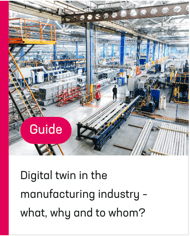The Digital Twin is a trendy term – and for good reason. It allows for monitoring, simulating, and testing both current and future processes. In manufacturing industries, the digital twin serves as a tool to identify bottlenecks, deviations, weak points, or critical areas in production. It also provides advance information about potential critical situations, thus preventing their occurrence.
Digital twins have been designed and implemented in the international arena already for a long time, whereas they are only just starting to be introduced to Finland. In the future models get even more realism, when, for example, virtual characters behave more naturally and react flexibly to changes in the environment. When connected to virtual reality, you get even more interactive simulation experiences. Like artificial intelligence, models become self-learning and, for example, their optimization abilities improve.
Expert guide to the use of the digital twin in industry
In this guide, we start with the basics: what does the digital twin mean exactly, what are its benefits, what could be useful starting points – and why, in most organizations, should creating a digital twin be considered rather a journey than a one-off purchase.
In this guide, we answer the following questions:
- What does the digital twin mean?
- What are the benefits and uses of the digital twin?
- How is the digital twin built?
- Where to start from in your own organization?

Download the guide by filling out the form. The guide is free of charge and downloading does not bind you to anything.